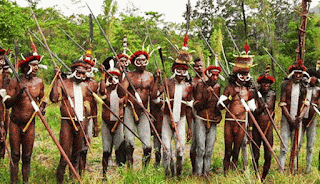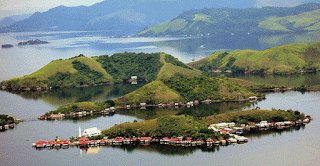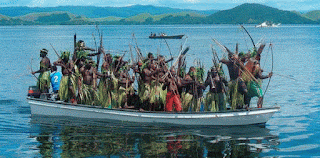East Papua / Irian Jaya
The Capital City of East Papua Province is
“Jayapura”
Jayapura, founded on 7 March 1910 as
Hollandia, had developed into a city with modern civil, educational, and
medical services in 1962. Since Indonesian administration services have been
replaced by Indonesian equivalents such as TNI (the army) replacing into Papua
Battalion. The name of the city has been changed to Kotabaru, then to
Sukarnopura and finally to its current official name. Among ethnic Papuans, it
is also known as Port Numbai, the former name before the arrival of
immigrants.Jayapura is the largest city, boasting a small but active tourism
industry; it is built on a slope overlooking the bay. Cenderawasih University
(UNCEN) campus stays at Abepura that is the houses of University Museum. Both
Tanjung Ria beach, near the market at Hamadi (site of the 22 April 1944 Allied
invasion during World War II) and the site of General Doughlas MacArthur's
World War II headquarters at Mount Ifar have monuments commemorating the
events.
The capital and the
biggest city of this eastern most Indonesian province. It is a neat and
pleasant city, built on the slope of a hill overlooking the bay. General
Douglas Mac Arthur’s World War II headquarters still stands here, as well as
some Japanese and Indonesian once. The Museum Jayapura is located inside the
Cendrawasih University.Tanjung Ria Beach, known as base G by the Allies during
World War II, is a popular holiday resort with facilities for water sports.
From skyline, in the hills behind the city, one gets a beautiful view of
Jayapura. The short trip for Jayapura, pleasant as it is, offers but a little
foretaste of the province’s magnificient scenery. Jotefa and Humboldt bays and
also the Lake Sentani Area.
Wide Area; The wide area of Papua is 420,000 sq km/162,000 sq mi.
Traditional
Costumes
Population
Papua population based on 2000 est. is
2,220,900. It has some 240 different tribal peoples, each with its own language
and culture. Indigenous Papuans in West Papua and Papua New Guinea speak some
15% of the world's known languages. West Papua together with the rest of the
island of New Guinea, are the lungs of the Asia-Pacific, containing the last
great surviving virgin rainforest after the Amazon.
Demographics
The population of Papua province and
the neighboring West Irian Jaya, both of which are still under a united
administration, totaled 2,646,489 in 2005. Since the early 1990s, Papua has had
the highest population growth rate of all Indonesian provinces at over 3%
annually. This is partly a result of high birth rates, but also from
immigration from other regions in Indonesia.According to the 2000 census, 78%
of the Papuan population identified themselves as Christian with 54% being
Protestant and 24% being Catholic. 21% of the population was Muslim and less
than 1% were Buddhist or Hindu. There is also substantial practice of animism
by Papuans, which is not recorded by the Indonesian government in line with the
policy of Pancasila.
Ecology
A vital tropical rainforest with the
tallest tropical trees and vast biodiversity, Papua's known forest fauna
includes marsupials (including possums, wallabies, tree-kangaroos, cuscuses),
other mammals (including the endangered Long-beaked Echidna), many bird species
(including birds of paradise, cassowaries, parrots, cockatoos), the world's
longest lizards (Papua monitor) and the world's largest butterflies. The island
has an estimated 16,000 species of plant, 124 genera of which are endemic.The
extensive waterways and wetlands of Papua are also home to salt and freshwater
crocodile, tree monitor, flying foxes, osprey, bats and other animals; while
the equatorial glacier fields remain largely unexplored.
In February 2006, a team of scientists
exploring the Foja Mountains, Sarmi, discovered numerous new species of birds,
butterflies, amphibians, and plants, including a species of rhododendron, which
may have the largest bloom of the genus. Ecological threats include
logging-induced deforestation, forest conversion for plantation agriculture
(especially oil palm), small holder agricultural conversion, the introduction
and potential spread of non-native alien species such as the Crab-eating
Macaque, which preys on and competes with indigenous species, the illegal
species trade, and water pollution from oil and mining operations.
Regions
Indonesia structures regions contains
of regencies and sub districts within those. Though names and areas of control
of these regional structures can vary over time in accord with changing
political and other requirements, in 2005 Papua province consisted of 19
regencies. The regencies are: Timika, Yapen - Waropen, Biak - Numfor, Nabire,
Puncak Jaya, Paniai, Jayawijaya, Merauke, Sarmi, Keerom, Waropen, Tolikara,
Yahukimo, Bintang Mountain, Boven Digoel, Mappi, Asmat, Supiori, and Jayapura.
In addition to these, Jayapura city also has the status of regency.
Government
Biak
Knicknack from Yenbuba
Many divers said that the best souvenir ever is the stories of your
experiences that you will take home to tell. But to keep your friends or family
consoled, try to bring these items: Asmat sculptures, Traditional cloths,
Hat, Necklaces, Noken (Traditional bag), Bracelet, Traditional music
instruments, Suling (traditional flute), Tambur (traditional drum). These you
can find also in gift shops in many cities in Papua. This will save you the
hassle of bringing too many things from Raja
Ampat.
Discover Paradise
Diving Paradise, As the richest area, Raja Ampat’s total number of confirmed corals to 537 species and 699 mollusks species. Some area boast enormous schools of fish and regular sighting of sharks, such as wobbegongs. In Mansuar, it’s highly likely you’ll encounter large groups of manta rays and turtles. From the boats and often close to shore, you may get the chance to done your snorkeling gear for some unforgettable interaction with resident pods of dolphins or even some passing whales. Weather. The temperature is generally hot. Light rains fall 189-399 mm per month between 22-29 days, which occurs a lot during the months of Januari to June whereas the dry season in between July to October.
Flora & Fauna
There are numerous types of flora in
this tropical area with its mystical tropical rain forest. The forest also has
a variety trees and other commercials important species plus the lush
vegetation of mangrove swamps. People grant their life by taking sago from the
sago palm forest.
The fauna is almost similar to
Australian fauna such as the group of fowl like pigeon, cockatoo, nuri (a kind
of parrot) and the reptile group such : crocodile, snake, turtle and monitor
lizard.
Underwater
Raja Ampat is all about diversity. It is not only diversity of species,
but also of dive spots. There are some areas where soft corals and sea fans
direct which can find in Yenbuba and its nearest islands, others with
amazing hard corals, black sand, and white sand. Then there are fish,
lots of them, in more figures and sizes than anywhere as well in the
world.
Aaccommodation
The Island provides
you in full comfort and distinct resort class although the site is in the most
remote resort area. The villas and bungalows were built in a large space, tastefully
decorated with the hospitality you would expect in the fine resort like
Wakatobi Dive Resort, a Swiss‐founded
that has an international standard with some facilities in Tomia Island. The
Architecture is built in consideration with the preservation of the traditional
building style, respect to the ecotourism principles with the main building and
bungalows crafted by local artisans and all using manual tools. Apart of their
land ‐based resort, the world ‐renowned Pelagian Yacht now operates and takes the
visitors in a local luxurious transportation.
Climate
The
Indonesian climate of Papua is quite tropical in character, with high
temperatures, plenty of strong sunshine and periods of heavy rain and wet
weather. Throughout the year, the temperatures of Papua rarely move far from
29°C / 84°F or 30°C / 86°F.Generally speaking, the climate of Papua is at its
most pleasant and favourable between April and September, which is often
described as the 'dry season'. However, if you are planning a holiday during
the dry season, it may well still rain at times, and it can in fact rain at
anytime in Indonesia, anywhere. Kota Biak, on the island of Pulau Biak, is an
especially damp part of the region. Papua
Weather and Climate: Seasonal Variations / When to Go - Papua, Indonesia, ID. The north and south coastlines of quite different and
feature their very own climate zones. In northern Papua, the weather can be
quite windy and rainy between the months of November and March, while on the
southerly shore, it can be a little wet between April and October, even though
this is actually considered to be the dry season in the south-easterly regency
of Merauke.
The objects of interest are:
Wakatobi
Diving Paradise, Dive
Spots, Biak, Biak Numfor, The Mumi, Bird
Watching, Kasuarina Cave, Besi
Island, Untouched Balliem Valley, The
Lani, The Yali, Lorentz
National Park, Sentani Lake, The
Skyline Hills, Japanese Cave, Parai
Blue River, Wasur National Park, Lampu
Satu Beach, Merauke.



























